Global Study On Child Poverty And Disparities (PDF) - Social Policy ...
Global Study On Child Poverty And Disparities (PDF) - Social Policy ...
Global Study On Child Poverty And Disparities (PDF) - Social Policy ...
You also want an ePaper? Increase the reach of your titles
YUMPU automatically turns print PDFs into web optimized ePapers that Google loves.
Box 1: <strong>Child</strong> poverty and equivalence scales<br />
Equivalence scales take into account the different resources required by households that differ in size and composition<br />
in terms of the number of adults and children, as well as the economies of scale within households.<br />
Equivalence scales can be expressed as an elasticity – how much does the addition of an extra member in a<br />
household change the total level of resources that the household needs in order to achieve a specified standard<br />
of living?<br />
At one extreme we could assume that household needs do not change with the addition of extra members: a<br />
household with five members needs no more than a household with one or two members. In this case, the elasticity<br />
would be zero. The assumption of zero elasticity is unrealistic; additional household members obviously<br />
must be fed and clothed. At the other extreme, it could be assumed that the elasticity is one – that is, each additional<br />
household member needs as much as a single adult. While this is more realistic than assuming an elasticity<br />
of zero, it is also unrealistic, since young children, for example, do not need as much food as adults, and some<br />
goods benefit from economies of scale – for example, it does not cost twice as much for a two-person household<br />
to cook dinner as for a single-person household.<br />
Equivalence scales are thus assumed to have an elasticity of between 0 and 1. The Table below shows a range<br />
of scales used in different studies and the elasticities associated with them. For example, most of the results<br />
in this report use the UNDP equivalence scales, which are developed as part of the process of specifying the<br />
poverty lines for different types of households in Vanuatu. The UNDP scale assumes that each additional adult<br />
needs as much as the first adult in a household, but that each child only needs half as much as an adult. This<br />
produces an elasticity of around 0.75. Many overseas studies use either the modified OECD equivalence scales<br />
or the square root scale. The modified OECD scale assumes that an additional adult requires half as much as<br />
the first adult, and each child requires 30 per cent of what an adult needs. The square root scale assumes that<br />
each additional person, adult or child, adds about 40 per cent and then about 30 per cent, and that each additional<br />
person needs slightly less than the previous person. Each of these scales has a lower elasticity than the<br />
UNDP scales. In the Table below, ‘1.0’ stands for the needs of a household containing one adult only<br />
Equivalence scales<br />
Household size<br />
Per-capita income<br />
(elasticity = 1)<br />
UNDP<br />
(elasticity = 0.75)<br />
modified OECD<br />
(elasticity = 0.53)<br />
Square root<br />
(elasticity = 0.50)<br />
Household income<br />
(elasticity = 0)<br />
1 adult 1.0 1.0 1.0 1.0 1<br />
2 adults 2.0 2.0 1.5 1.4 1<br />
2 adults, 1 child 3.0 2.5 1.8 1.7 1<br />
2 adults, 2<br />
children<br />
2 adults, 3<br />
children<br />
4.0 3.0 2.1 2.0 1<br />
5.0 3.5 2.4 2.2 1<br />
The use of different scales can produce quite different estimates of poverty. As can be seen from the Table, the<br />
UNDP scale assumes that a household of five people (approximately the average household size in Vanuatu)<br />
needs 3.5 times as much as a single-person household, while the modified OECD scale assumes that a household<br />
of five people needs 2.4 times as much as a single person, and the square root scale assumes that this<br />
household needs 2.2 times as much as a single person. Different scales therefore produce different poverty lines<br />
for each household type, and estimated poverty rates therefore differ. For example, if the modified OECD equivalence<br />
scale is used rather than the UNDP scale, then the estimated poverty rate for children would be reduced by<br />
up to 60 per cent.<br />
Separate FPLs have been calculated (VNSO, ADB and UNDP 2008) for both national and sub-national<br />
dimensions for three areas (rural, Port Vila and Luganville). They were estimated from the actual food<br />
expenditure patterns recorded in HIES survey diaries for households in the lowest three deciles of<br />
expenditure, measured in per-capita adult-equivalent terms.<br />
34
















